Simulated Soil Organic Carbon Density Changes from 1980 to 2016 in Shandong Province Dry Farmlands Using the CENTURY Model
Abstract
:1. Introduction
2. Materials and Methods
2.1. Study Area
2.2. Study Method
2.3. Soil Data
2.4. Model Initialization and Parameterization
2.5. SOCD Calculation
2.6. Model Validation
3. Results
3.1. Result of Model Validation
3.1.1. Result of Point Validation
3.1.2. Result of Multi-Point Validation
3.2. SOC Temporal Changes
3.3. Temporal Evolution of SOC in Different Soil Orders
3.4. SOC Spatial Variation
4. Discussion
5. Conclusions
Author Contributions
Funding
Conflicts of Interest
References
- Han, R.Q.; Zhen, D.; Dai, E.F.; Wu, S.H.; Zhao, M.H. Response of production potential to climate fluctuation in major grain regions of China. Resour. Sci. 2014, 36, 2611–2623. [Google Scholar]
- Zhang, A.H. The impact of global warming on world agriculture. Guangdong Canye 2016, 50, 10–11. [Google Scholar]
- Jin, D.X. Climate warming and its impact on agriculture. Environ. Prot. 1992, 8, 32–34. [Google Scholar]
- Yang, X.M. Using agricultural soils to fix organic carbon—Alleviating global warming and improving soil productivity. Soil Environ. Sci. 2000, 9, 311–315. [Google Scholar]
- Yang, X.M.; Zhang, X.P.; Fang, H.J. The significance of carbon sequestration in agricultural soils to alleviate global warming. Sci. Geogr. Sin. 2003, 23, 101–106. [Google Scholar]
- Intergovernmental Panel on Climate Change. Climate Change 1995: Impact, Adaptation and Mitigation: Scientific Technical Analyses; Working Group 1; Cambridge University Press: Cambridge, UK, 1996. [Google Scholar]
- Lal, R. Soil erosion and gaseous emissions. Appl. Sci. 2020, 10, 2784. [Google Scholar] [CrossRef] [Green Version]
- Sornpoon, M.; Bonnet, S.; Garivait, S. Effect of open burning on soil carbon stock in sugarcane plantation in Thailand. World Acad. Sci. Eng. Technol. 2014, 8, 822–827. [Google Scholar]
- Ray, R.L.; Griffin, R.W.; Fares, A.; Elhassan, A.; Awal, R.; Woldesenbet, S.; Risch, E. Soil CO2 emission in response to organic amendments, temperature, and rainfall. Sci. Rep. 2020, 10, 5849. [Google Scholar] [CrossRef] [Green Version]
- Cole, C.V.; Wastion, R.T.; Zinyowera, M.C.; Moss, R.H. Agriculture Options for Mitigation of Greenhouse Gas Emission. Climate Change 1995: Impacts, Adaptations and Mitigation of Climate Change: Intergovernmental Panel on Climate Change; Cambrige University Press: Cambrige, UK, 1996; pp. 1–27. [Google Scholar]
- Mathew, I.; Shimelis, H.; Mutema, M.; Minasny, B.; Chaplot, V. Crops for increasing soil organic carbon stocks—A global meta analysis. Geoderma 2020, 367, 114230. [Google Scholar] [CrossRef]
- Ardö, J.; Olsson, L. Assessment of soil organic carbon in semi-arid Sudan using GIS and the CENTURY model. J. Arid Environ. 2003, 54, 633–651. [Google Scholar] [CrossRef]
- Zhang, D.J.; Zong, J.J.; Ma, J.H.; Yang, X.Q.; Hu, X.; Xu, S. The influence of wheat maize annual cultivation mode and increasing application of organic fertilizer on soil organic carbon pool and greenhouse gas emission of summer maize. Ecol. Environ. Sci. 2019, 28, 1927–1935. [Google Scholar]
- Zhang, D.J.; Wang, Y.J.; Chen, Q.Q.; Yang, X.Q.; Zong, J.Q.; Li, C.X. Effects of different cultivation methods and increased application of organic fertilizer on soil organic carbon pool and wheat yield in wheat field. Jiangsu Agric. Sci. 2019, 47, 128–133. [Google Scholar]
- Liu, S.J.; Zhang, H.P.; Li, T.; Shen, L.Y.; Xu, C.Y.; Han, J. Effects of Farming Methods on Soil Characteristics and Winter Wheat Yield in Northwest Dryland Farmland. A Cta A Gricult. Boreali-Occident. Sin. 2019, 28, 1411–1418. [Google Scholar]
- Mohamed, L.S. Effects of Tillage and Straw Returning on Yield and Greenhouse Gas Emissions of Double Cropping Rice; Chinese Academy of Agricultural Sciences: Beijing, China, 2018. [Google Scholar]
- Meki, M.N.; Kemanian, A.R.; Potter, S.R.; Bumenthal, J.M.; Williams, J.R.; Gerik, T.J. Cropping system effects on sorghum grain yield, soil organic carbon, and global warming potential in central and south Texas. Agric. Syst. 2013, 117, 19–29. [Google Scholar] [CrossRef]
- Adviento-Borbe, M.A.A.; Haddix, M.L.; Binder, D.L.; Walters, D.T.; Dobermann, A. Soil greenhouse gas fluxes and global warming potential in four high-yielding maize systems. Glob. Chang. Biol. 2007, 13, 1972–1988. [Google Scholar] [CrossRef]
- Wang, H.; Ren, T.; Yang, H.; Feng, Y.Q.; Liu, G.S.; Yin, Q.Y.; Shi, H.Z. Research and application of biochar in soil CO2 emission, fertility, and microorganisms: A sustainable solution to solve China’s agricultural straw burning problem. Sustainability 2020, 12, 1922. [Google Scholar] [CrossRef] [Green Version]
- Wang, K.F. Coupling Development of Triple-Microbe Model and Its Simulation of Global Soil Organic Carbon and Microbial Carbon; Northwest A&Forestry University: Shaanxi, China, 2017. [Google Scholar]
- Bohn, H.L. Estimate of organic carbon in world soils. Soil Sci. Soc. Am. J. 1982, 46, 1118–1119. [Google Scholar] [CrossRef]
- Jobbágy, E.G.; Jackson, R.B. The vertical distribution of soil organic carbon and its relation to climate and vegetation. Ecol. Appl. 2000, 10, 423–436. [Google Scholar] [CrossRef]
- Wang, S.Q.; Zhou, C.H. Estimating soil organic carbon reservior of terrestrial ecosystem in China. Geogr. Res. 1999, 18, 349–356. [Google Scholar]
- Ye, M.X.; Zhao, S.D.; Liu, D. Research state of soil carbon cycling in terrestrial ecosystem. Chin. J. Ecol. 1999, 18, 29–351. [Google Scholar]
- Althoff, T.D.; Menezes, R.S.C.; Pinto, A.D.S.; Pareyn, F.G.C.; Carvalho, A.L.D.; Martins, J.C.R.; Carvalho, E.X.D.; Silva, A.S.A.D.; Dutra, E.D.; Sampaio, E.V.D.S.B. Adaptation of the CENTURY model to simulate C and N dynamics of Caatinga dry forest before and after deforestation. Agric. Ecosyst. Environ. 2018, 254, 26–34. [Google Scholar] [CrossRef]
- Tarnocai, C.; Canadell, J.G.; Schuur, E.A.G.; Kuhry, P.; Mazhitova, G.; Zimov, S. Soil organic carbon pools in the Northern Circumpolar permafrost region. Glob. Biogeochem. Cycles 2009, 23, 1–11. [Google Scholar] [CrossRef]
- Luo, W.; Zhang, H.H.; Chen, J.J.; Liu, Y.; Li, D.Q. Storage and spatial distribution of soil organic carbon in Guangdong Province. Ecol. Environ. Sci. 2018, 27, 1593–1601. [Google Scholar]
- Zhang, J.; Lin, M.; Ao, Z.Q. Estimation of soil organic carbon storage in arid areas of Western China. J. Arid Area Resour. Environ. 2018, 32, 132–137. [Google Scholar]
- Yang, A.G.; Miao, Z.H.; Qiu, F.F.; Yang, Q.C.; Wang, Z.M.; Mao, D.H. Estimation and spatial distribution of organic carbon storage in topsoil of Sanjiang Plain based on GIS. Bull. Soil Water Conserv. 2015, 35, 155–158. [Google Scholar]
- Han, B.; Wang, X.K.; Ou, Y.Z.Y. Distribution and change of agro-ecosystem carbon pool in Northeast of China. Chin. J. Soil Sci. 2004, 35, 1140–1147. [Google Scholar]
- Xiao, X.M.; Wang, Y.F.; Chen, Z.Z. Dynamics of primary productivity and soil organic matter of typical steppe in the Xilin River Basin of Inner Mongolia and their responses to climate change. J. Integr. Plant Biol. 1996, 38, 45–52. [Google Scholar]
- Zhang, Y.Q.; Tang, Y.H.; Jiang, J. Dynamic characteristics of soil organic carbon in grassland ecosystems of the Qinghai-Tibet Plateau. Sci. Sin. 2006, 36, 1140–1147. [Google Scholar]
- Fang, H.J.; Yang, X.M.; Zhang, X.P.; Shen, Y. Simulation on dynamic of soil organic carbon under the effect of tillage and water erosion. Acta Pedol. Sin. 2006, 43, 730–735. [Google Scholar]
- Shen, W.J.; Peng, S.L.; Wu, J.G.; Lin, Y.B. Simulation studies on carbon and nitrogen accumulation and its allocation pattern in forest ecosystems of Heshan in low subtropical China. J. Trop. Subtrop. Bot. 2003, 27, 690–699. [Google Scholar]
- Parton, W.J.; Schimel, D.S.; Cole, C.V.; Ojima, D.S. Analysis of factors controlling soil organic matter levels in Great Plains Grasslands. Soil Sci. Soc. Am. J. 1987, 51, 1173–1179. [Google Scholar] [CrossRef]
- Yang, R.G.; Bi, J.J.; Zhang, Y.H.; Xing, J.Z.; Hao, L.C. Agricultural drought trend in Shandong Province and development of agricultural technology in dry farmland. Anhui Agric. Sci. Bull. 2007, 13, 44–45. [Google Scholar]
- Shi, X.Z.; Yu, D.S.; Sun, W.X.; Wang, H.J.; Zhao, Q.G.; Gong, Z.T. Reference benchmark study of soil classification system between China and the United States: Reference between soil types and soil classification of the American system classification. Chin. Sci. Bull. 2004, 49, 1299–1303. [Google Scholar]
- Zhang, S.H.; Peng, G.B.; Huang, M. The Feature extraction and data fusion for regional soil texture based on GIS techniques. Clim. Environ. Res. 2004, 9, 65–79. [Google Scholar]
- Metherell, A.K.; Harding, L.A.; Cole, C.V.; Parton, W.J. CENTURY Soil Organic Matter Model Environment; Version 4.0; United States Department of Agriculture, Agricultrual Research Service: Fort Collins, CO, USA, 1993; pp. 69–77. Available online: https://www2.nrel.colostate.edu/projects/century/MANUAL/html_manual/man96.html (accessed on 3 July 2020).
- Yu, S.S.; Dou, S.; Yang, J.M. Application of central model in soil organic carbon research. Soils Crop. 2014, 3, 10–14. [Google Scholar]
- Soil Survey Staff, Soil Survey Laboratory Information Manual; Version 2.0. USDA-NRCS; Soil Survey Investigations Report NO.45; U.S. Government Publishing Office: Washington, DC, USA, 2011; pp. 235–253.
- Fang, J.Y.; Liu, G.H.; Xu, S.L. Carbon pools of terrestrial ecosystems in China. In Greenhouse Gas Concentration and Emission Monitoring and Related Processes; Wang, G.C., Wen, Y.P., Eds.; China Environmental Science Press: Beijing, China, 1996; pp. 102–128. [Google Scholar]
- Foereid, B.; Barthram, G.T.; Marriott, C.A. The CENTURY model failed to simulate soil organic matter development in an acidic grassland. Nutr. Cycl. Agroecosyst. 2007, 78, 143–153. [Google Scholar] [CrossRef]
- Bista, P.; Machado, S.; Ghimire, R.; Grosso, S.J.D.; Reyes-Fox, M. Simulating soil organic carbon in a Wheat–Fallow System using the Daycent model. Agron. J. 2016, 108, 2554–2565. [Google Scholar] [CrossRef]
- Maren Oelbermann, R.P. An evaluation of the CENTURY model to predict soil organic carbon: Examples from Costa Rica and Canada. Agrofor. Syst. 2011, 82, 37–50. [Google Scholar] [CrossRef]
- Silver, W.L.; Neff, J.; McGroddy, M.; Veldkamp, E.; Keller, M.; Cosme, R. Effects of soil texture on belowground carbon and nutrient storage in a lowland Amazonian forest ecosystem. Ecosystems 2000, 3, 193–209. [Google Scholar] [CrossRef]
- Liu, X.Y.; Zhao, Y.C.; Shi, X.Z.; Wang, S.H.; Yu, D.S. Uncertainty in CENTURY-modelled changes in soil organic carbon stock in the uplands of Northeast China, 1980–2050. Nutr. Cycl. Agroecosyst. 2019, 113, 77–93. [Google Scholar] [CrossRef]
- Wu, F.; Wang, X.K.; Han, B.; Ouyang, Z.Y.; Zheng, H. Greenhouse gas leakage and net emission reduction potential of carbon sequestration measures in farmland soils. Acta Ecol. Sin. 2009, 29, 4993–5006. [Google Scholar]
- Lu, F.; Wang, X.K.; Han, B.; Ouyang, Y.Z.; Zheng, H. Researches on the greenhouse gas leakage and net mitigation potentials of soil carbon sequestration measures in croplands. Acta Ecoiogica Sin. 2009, 29, 4993–5003. [Google Scholar]
- Wu, F.; Wang, X.K.; Han, B.; Ouyang, Z.Y.; Zheng, H. Returning straw from paddy field to soil: Carbon sequestration in soil and increased methane emission. Chin. J. Appl. Ecol. 2010, 21, 99–108. [Google Scholar]
- Li, C.; Frolking, S.; Butterbach-Bahl, K. Carbon sequestration in arable soils is likely to increase nitrous oxide emissions, offsetting reductions in climate radiative forcing. Clim. Chang. 2005, 72, 321–338. [Google Scholar] [CrossRef]
- Dai, R.J.; Pang, X.G.; Dong, J.; Wang, Z.H.; Yu, C. Soil organic carbon pool and temporal variation characteristics in Shandong Province. Geoscience 2017, 31, 386–393. [Google Scholar]
- Liang, E.; Cai, D.X.; Zhang, D.C.; Dai, K.; Feng, Z.H.; Liu, S.; Wang, Y.; Wang, X.B. Terrestrial soil organic carbon storage in China: Estimated and uncertainty. Soil Fertil. Sci. China 2010, 6, 75–79. [Google Scholar]
- Safanelli, J.L.; Chabrillat, S.; Ben-Dor, E.; Demattê, J.A.M. Multispectral Models from Bare Soil Composites for Mapping Topsoil Properties over Europe. Remote Sens. 2020, 12, 1369. [Google Scholar] [CrossRef]
- Gholizadeh, A.; Saberioon, M.; Rossel, R.A.V.; Boruvka, L.; Klement, A. Spectroscopic measurements and imaging of soil colour for field scale estimation of soil organic carbon. Geoderma 2020, 357, 113972. [Google Scholar] [CrossRef]
- Wang, S.; Zhuang, Q.; Jin, X.; Yang, Z.; Liu, H. Predicting soil organic carbon and soil nitrogen stocks in topsoil of forest ecosystems in Northeastern China using remote sensing data. Remote Sens. 2020, 12, 1115. [Google Scholar] [CrossRef] [Green Version]
- Taghizadeh-Mehrjardi, R.; Schmidt, K.; Amirian-Chakan, A.; Rentschler, T.; Zeraatpisheh, M.; Sarmadian, F.; Valavi, R.; Davatgaar, N.; Behrens, T.; Scholten, T. Improving the spatial prediction of soil organic carbon content in Ttwo contrasting climatic regions by stacking machine learning models and rescanning covariate space. Remote Sens. 2020, 12, 1095. [Google Scholar] [CrossRef] [Green Version]
- Xie, Z.B.; Zhu, J.G.; Liu, G.; Cadisch, G.; Hasegawa, T.; Chen, C.M.; Sun, H.F.; Tang, H.Y.; Zeng, Q. Soil organic carbon stocks in China and changes from 1980s to 2000s. Glob. Chang. Biol. 2007, 13, 1989–2007. [Google Scholar] [CrossRef]
- Dai, R.J.; Pang, X.G.; Zeng, X.D.; Wang, H.J. Soil carbon density and distribution and influencing factors in Shandong Province. Res. Environ. Sci. 2015, 28, 1449–1458. [Google Scholar]
- Wang, S.Q.; Zhou, C.H.; Li, K.R.; Zhu, S.L.; Huang, F.H. Analysis on spatial distribution characteristics of soil organic carbon reservoir in China. Acta Geogr. Sin. 2000, 55, 533–544. [Google Scholar]
- Chen, X. Estimation of soil organic carbon reserves in Guangxi and comparison study with some provinces in China. Sci. Geogr. Sin. 2014, 34, 1247–1253. [Google Scholar]
- Yu, J.J.; Yang, F.; Wu, K.N.; Li, L.; Lu, Q.L. Soil organic carbon storage and its spatial distribution in Henan Province. Chin. J. Appl. Ecol. 2008, 19, 1058–1063. [Google Scholar]
- Bao, L.R.; Yan, M.S.; Jia, Z.M.; Gong, Y.Y. The distribution of surface soil organic carbon storage and density in western Chongqing. Geophys. Geochem. Explor. 2015, 39, 180–185. [Google Scholar]
- Wen, Y.; Deng, N.R.; Liu, X.N.; Cheng, J.; Wei, J.B. Variations of soil organic carbon of cropland topsoil in mountain area of northern Guangdong over 25 year. Ecol. Environ. Sci. 2011, 20, 1247–1252. [Google Scholar]
- Ma, B.; Zhou, P.; Tong, C.L.; Xiao, H.A.; Yang, Y.C.; Wu, J.S. Change in soil organic carbon with different land uses in subtropical hilly red soil region. Res. Agric. Mod. 2017, 38, 176–181. [Google Scholar]
- Xu, X.W.; Pan, G.X.; Sun, X.L.; Xue, F. Changing characteristics and sequestration of farmland topsoil organic carbon in Guichi County Anhui Province. J. Agro-Environ. Sci. 2009, 28, 2551–2558. [Google Scholar]
- Fang, J.Y.; Chu, S.S.; Wang, J.; Wu, D.M.; Mo, Q.F.; Gao, J.; Lin, J.H.; Zeng, S.C. Soil organic carbon density and its relationship with soil physical properties of typical plantations in South China. J. South China Agric. Univ. 2018, 39, 83–90. [Google Scholar]
- Zhao, J.F.; Yan, X.D.; Jia, G.S. Simulation of carbon stocks of forest ecosystems in Northeast China 1981–2002. Chin. J. Appl. Ecol. 2009, 20, 241–249. [Google Scholar]
- Yang, X.M.; Cheng, J.M.; Meng, L.; Han, J.J. Features of soil organic carbon storage and vertical distribution in different forests. Chin. Agric. Sci. Bull. 2010, 26, 132–135. [Google Scholar]
- Guo, L.H.; Gao, J.B.; Wu, S.H.; Hao, C.Y.; Zhao, D.S. Spatial-temporal change of soil organic carbon and its susceptibility to climate change in Inner Mongolia Grassland 1981–2010. Res. Environ. Sci. 2016, 29, 1050–1058. [Google Scholar]
- Zeng, Y.N.; Feng, Z.D.; Cao, G.C.; Xue, L. Soil organic carbon storage and distribution characteristics of alpine grassland in the source region of the Yellow River. Acta Geogr. Sin. 2004, 59, 497–504. [Google Scholar]
- Li, K.P.; Zhao, H.; Hou, X.W.; Jian, S.C.; Ma, G.Z. Situation analysis and counter measures research on the agricultural mechanization development in Shandong Province. J. Chin. Agric. Mech. 2018, 39, 97–100. [Google Scholar]
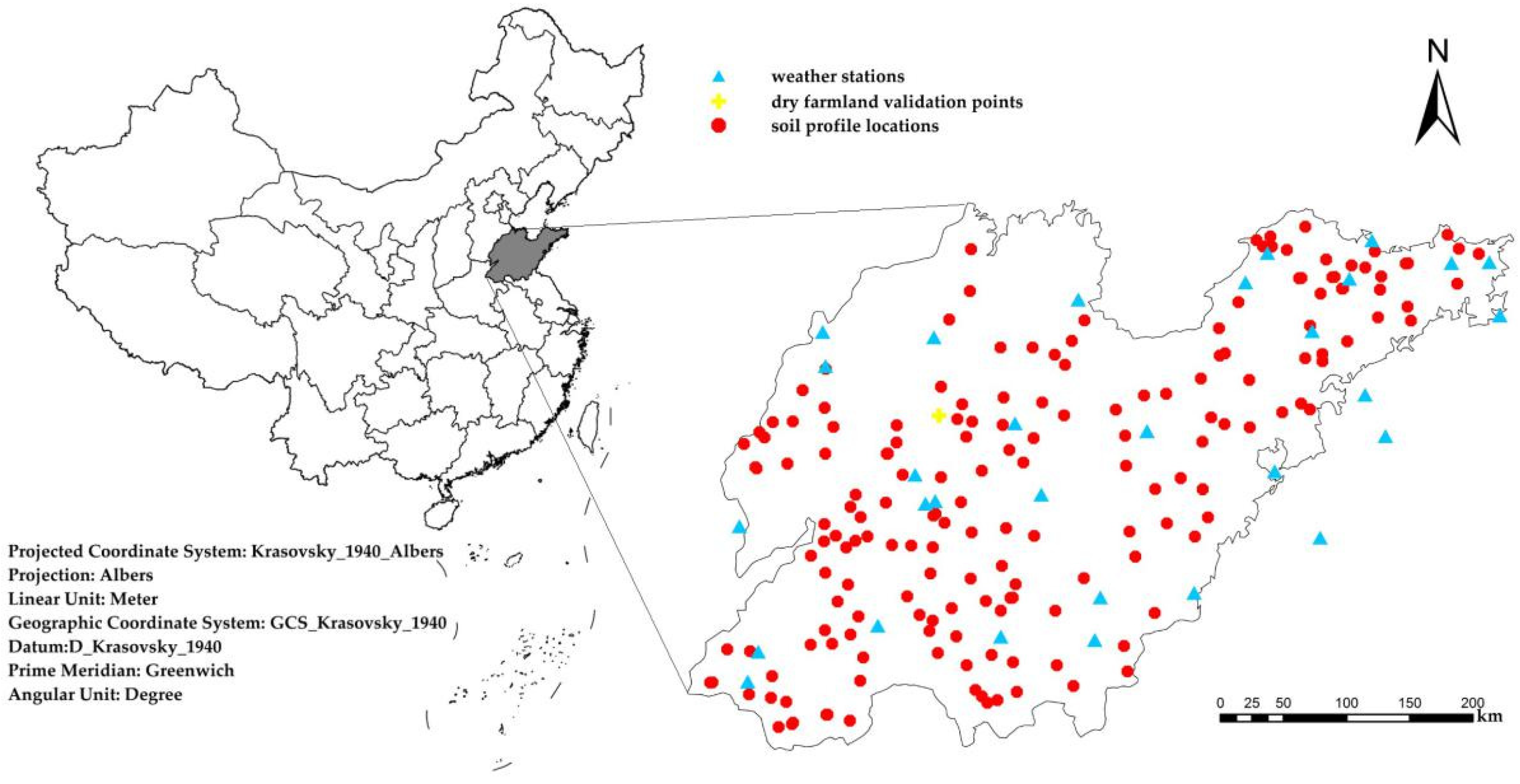
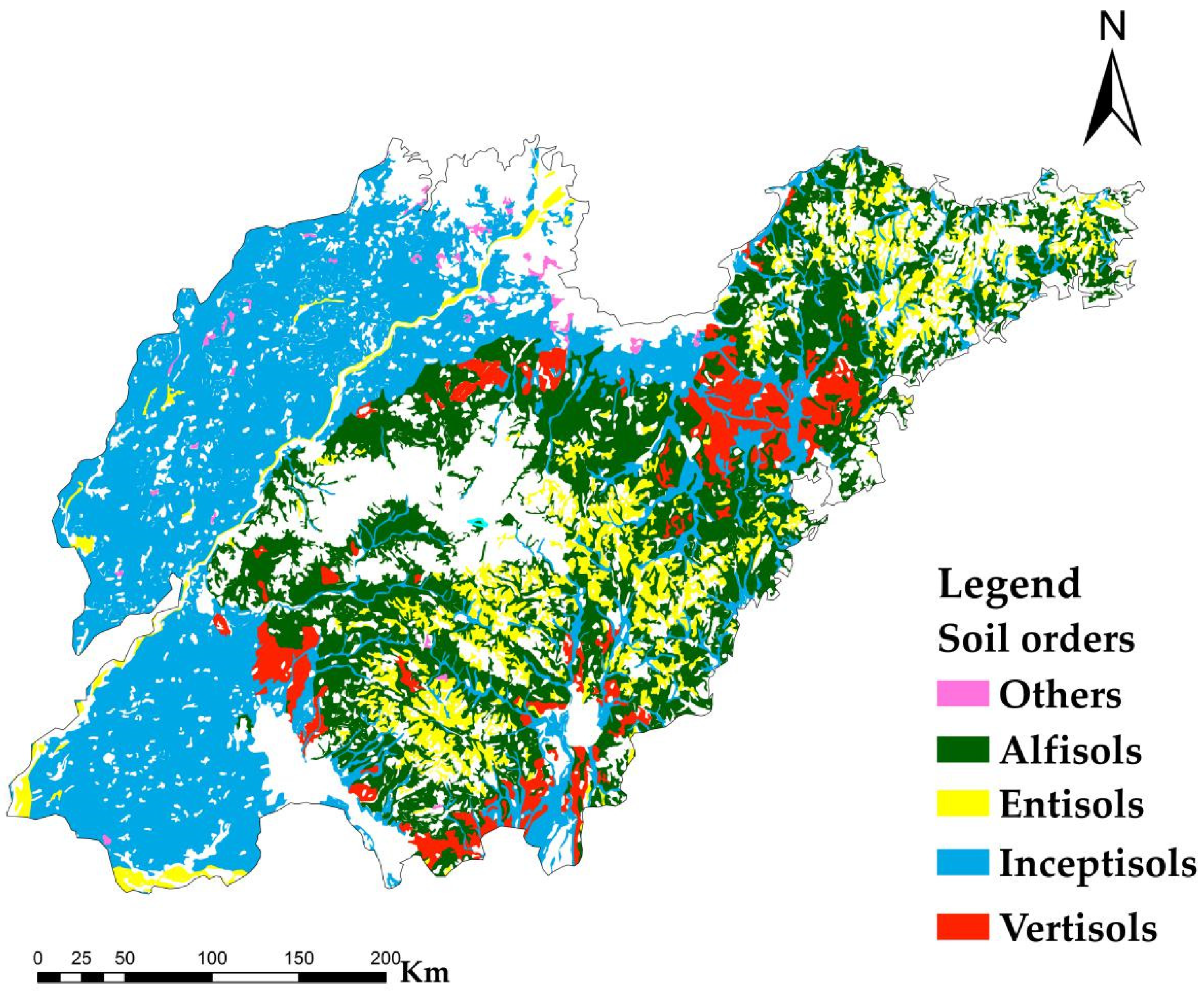
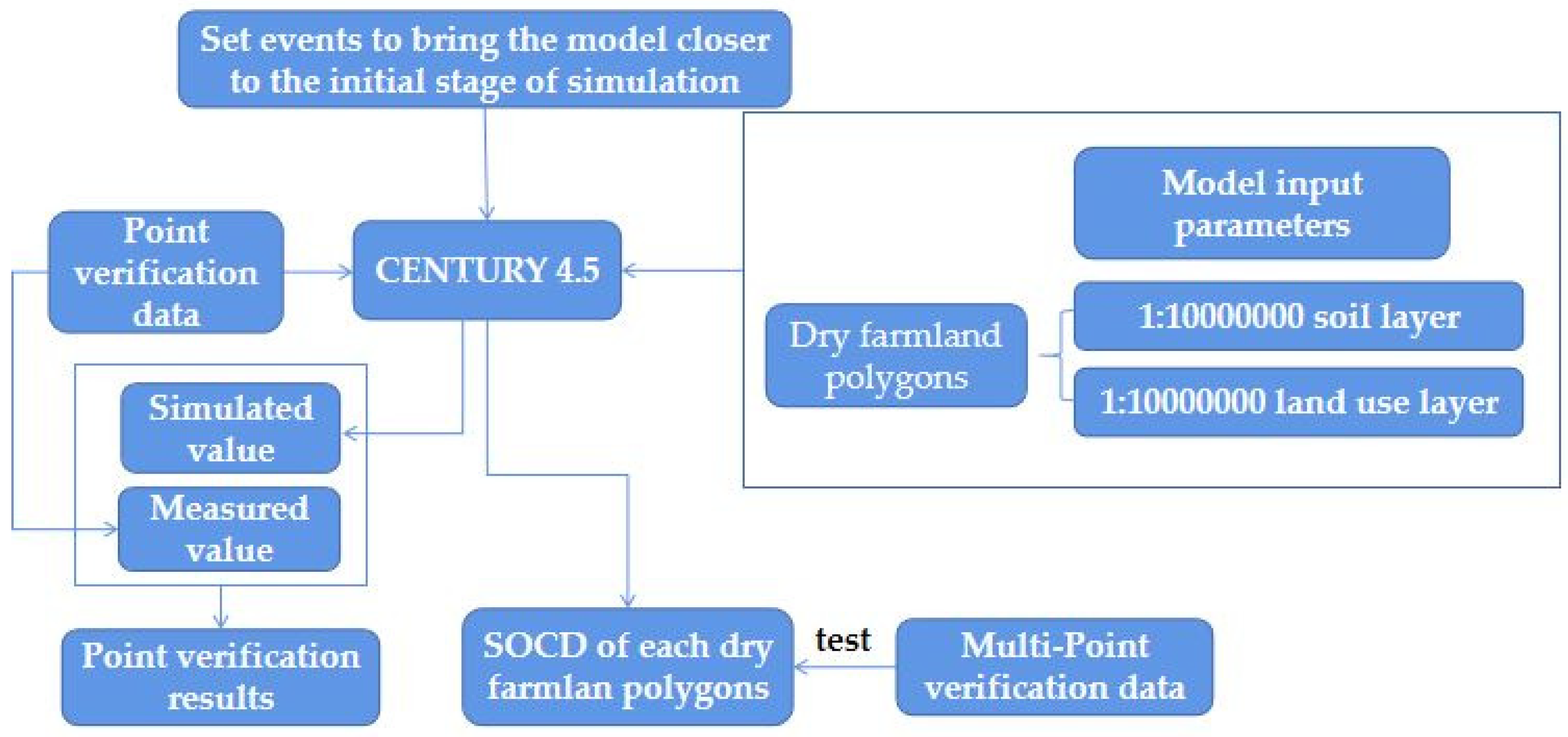

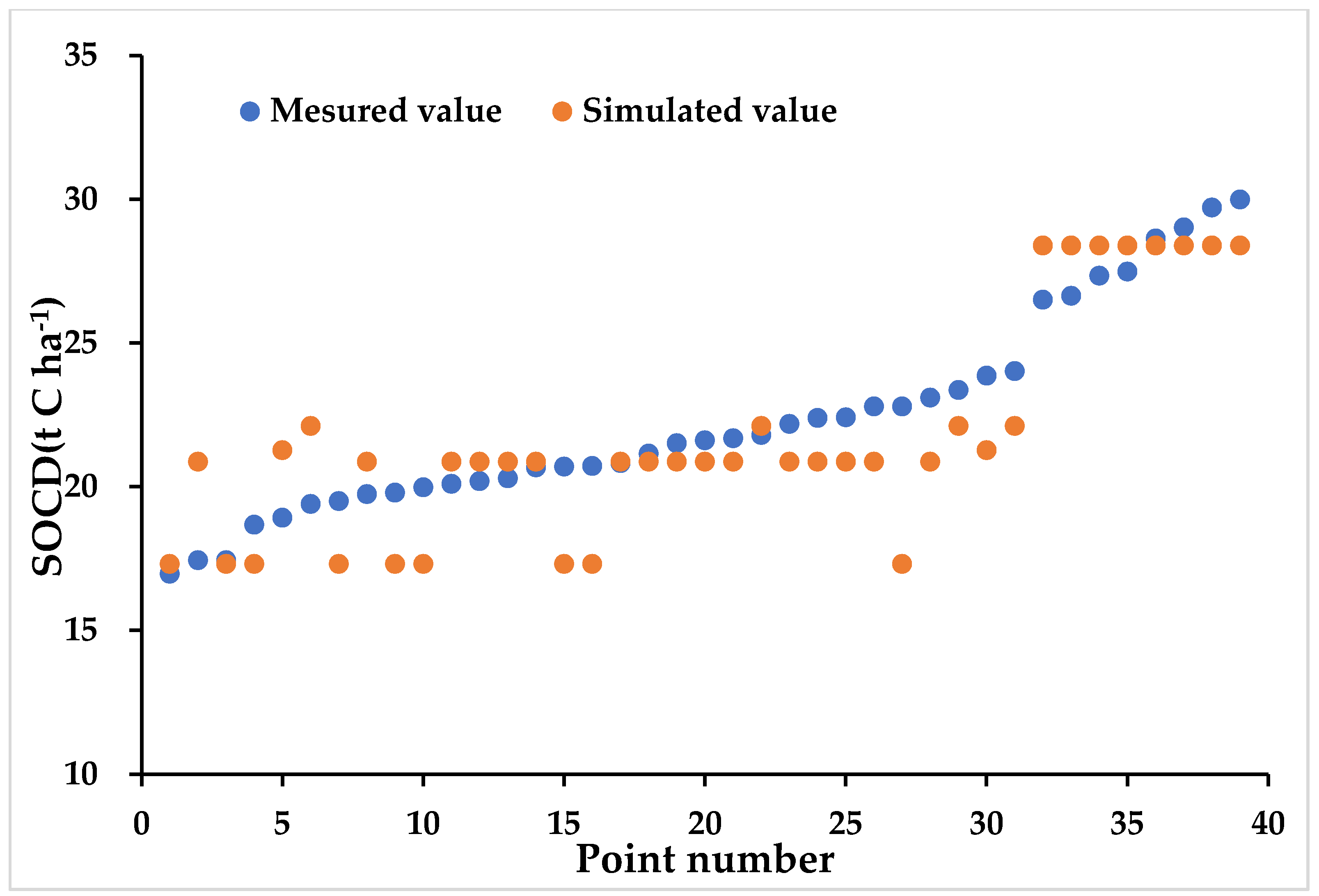
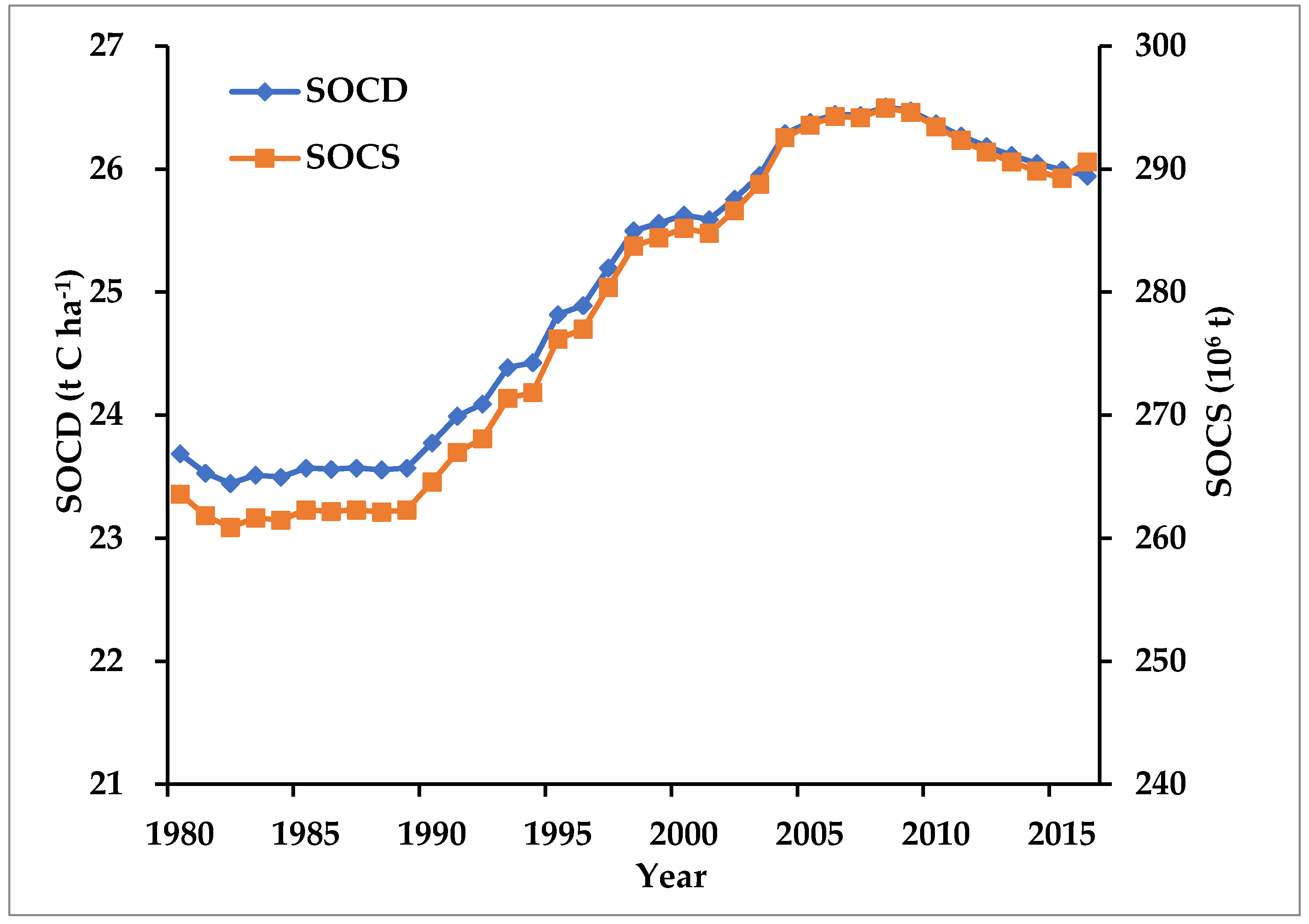
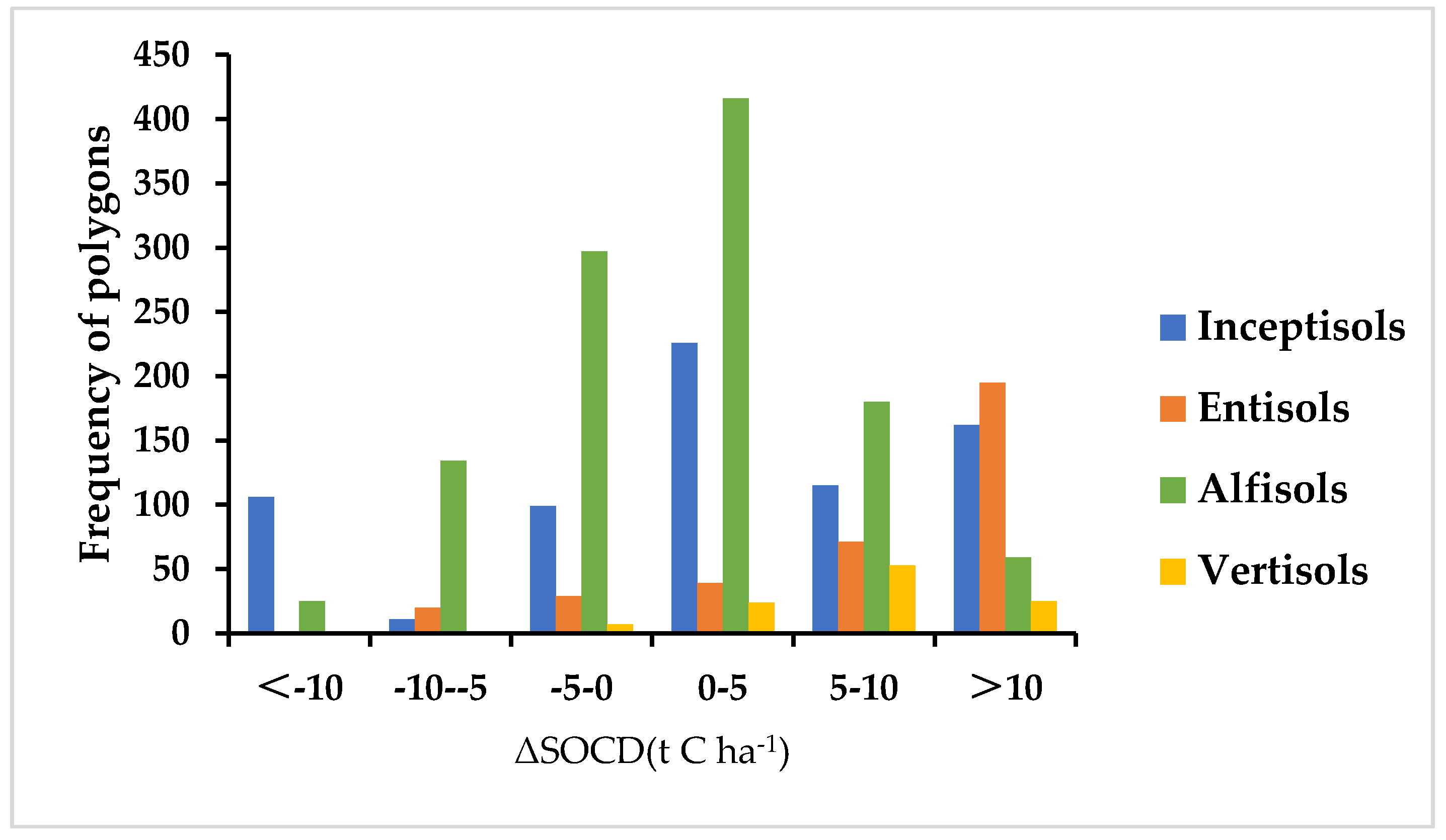
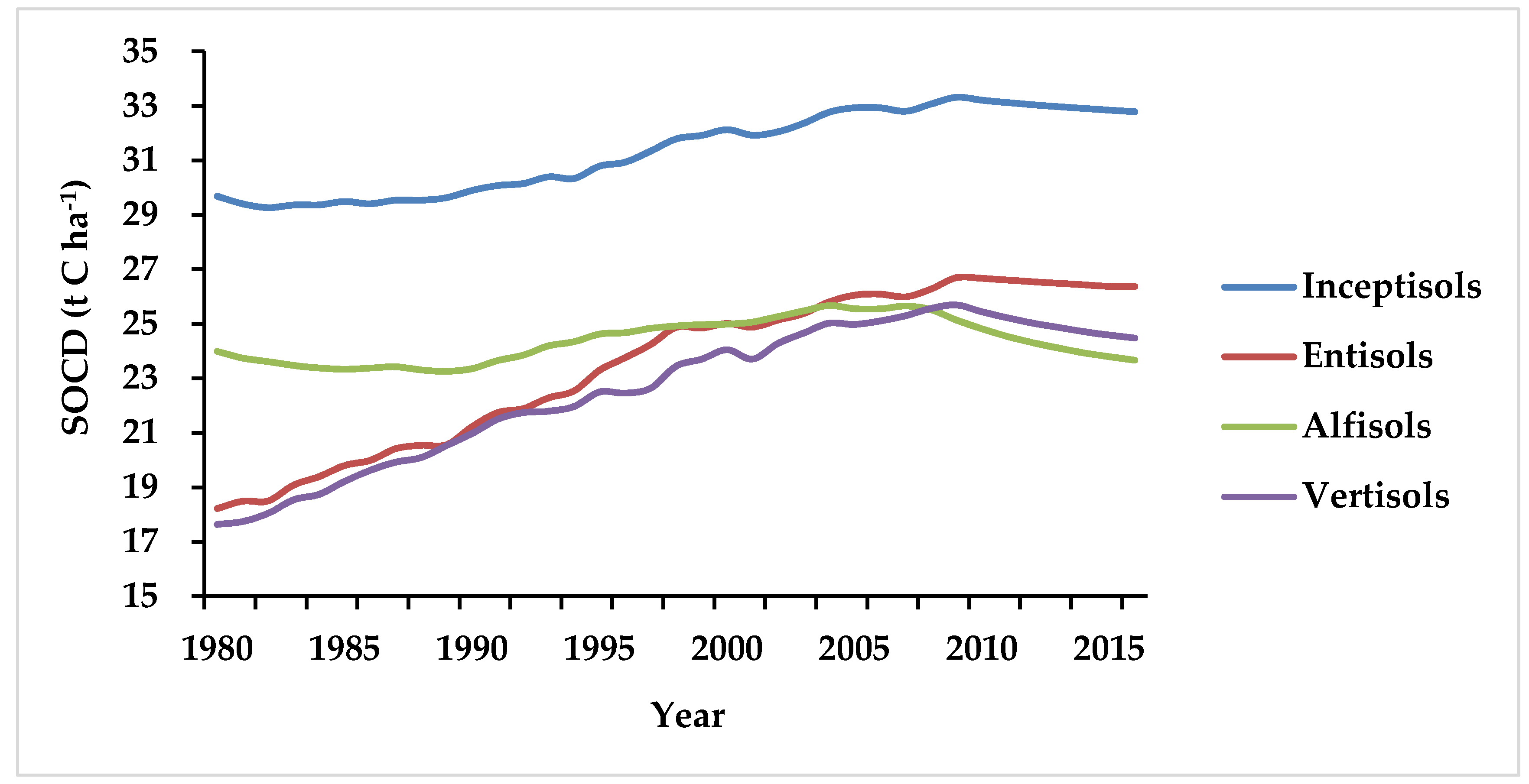

| Order | Sand | Silt | Clay | BD | pH | SOC |
|---|---|---|---|---|---|---|
| ----------%---------- | (g/cm3) | (g/kg) | ||||
| Inceptisols | 52.95 | 30.15 | 16.90 | 1.35 | 7.75 | 5.87 |
| Entisols | 71.39 | 17.39 | 10.98 | 1.36 | 6.91 | 3.73 |
| Alfisols | 58.05 | 23.28 | 18.67 | 1.33 | 7.01 | 5.61 |
| Vertisols | 40.52 | 31.66 | 27.82 | 1.42 | 7.65 | 7.03 |
| Site | Longitude/Latitude | Year Range | Crop Rotation | pH | BD | Sand | Silt | Clay | Order |
|---|---|---|---|---|---|---|---|---|---|
| g/cm3 | — | % | — | ||||||
| Jinan | 117.28° E/ 36.75° N | 1986–2007 | Winter Wheat-Corn | 7.7 | 1.36 | 61.5 | 20.9 | 17.6 | Inceptisols |
| Area | Number | Order | Soil Organic Carbon Density (SOCD) (t C ha−1) | |
|---|---|---|---|---|
| Range of Value | Average Value | |||
| Lingxian county | 39 | Inceptisols | 16.97–29.99 | 22.34 |
| Profile Number | Min | Max | Average | Range | Standard Deviation | Variance | |
|---|---|---|---|---|---|---|---|
| —— | t/ha | —— | |||||
| SOCD1980 | 2392 | 5.54 | 150.64 | 23.69 | 145.1 | 15.11 | 228.41 |
| SOCD1985 | 2392 | 6.01 | 135.89 | 23.57 | 129.88 | 13.90 | 193.16 |
| SOCD1990 | 2392 | 6.08 | 120.72 | 23.78 | 114.64 | 13.00 | 168.92 |
| SOCD1995 | 2392 | 6.98 | 112.19 | 24.82 | 105.21 | 12.15 | 147.51 |
| SOCD2000 | 2392 | 7.10 | 106.98 | 25.63 | 99.88 | 11.96 | 143.09 |
| SOCD2005 | 2392 | 7.05 | 104.22 | 26.38 | 97.17 | 11.80 | 139.20 |
| SOCD2010 | 2392 | 6.90 | 100.92 | 26.37 | 94.02 | 11.79 | 138.96 |
| SOCD2016 | 2392 | 6.09 | 98.12 | 25.94 | 92.03 | 11.89 | 141.45 |
© 2020 by the authors. Licensee MDPI, Basel, Switzerland. This article is an open access article distributed under the terms and conditions of the Creative Commons Attribution (CC BY) license (http://creativecommons.org/licenses/by/4.0/).
Share and Cite
Tang, M.; Wang, S.; Zhao, M.; Qin, F.; Liu, X. Simulated Soil Organic Carbon Density Changes from 1980 to 2016 in Shandong Province Dry Farmlands Using the CENTURY Model. Sustainability 2020, 12, 5384. https://doi.org/10.3390/su12135384
Tang M, Wang S, Zhao M, Qin F, Liu X. Simulated Soil Organic Carbon Density Changes from 1980 to 2016 in Shandong Province Dry Farmlands Using the CENTURY Model. Sustainability. 2020; 12(13):5384. https://doi.org/10.3390/su12135384
Chicago/Turabian StyleTang, Min, Shihang Wang, Mingsong Zhao, Falyu Qin, and Xiaoyu Liu. 2020. "Simulated Soil Organic Carbon Density Changes from 1980 to 2016 in Shandong Province Dry Farmlands Using the CENTURY Model" Sustainability 12, no. 13: 5384. https://doi.org/10.3390/su12135384




